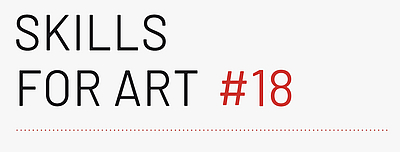Welcome at the Interface Culture program website.
Acting as creative artists and researchers, students learn how to advance the state of the art of current interface technologies and applications. Through interdisciplinary research and team work, they also develop new aspects of interface design including its cultural and social applications. The themes elaborated under the Master's programme in relation to interactive technologies include Interactive Environments, Interactive Art, Ubiquitous Computing, game design, VR and MR environments, Sound Art, Media Art, Web-Art, Software Art, HCI research and interaction design.

The Interface Culture program at the Linz University of Arts Department of Media was founded in 2004 by Christa Sommerer and Laurent Mignonneau. The program teaches students of human-machine interaction to develop innovative interfaces that harness new interface technologies at the confluence of art, research, application and design, and to investigate the cultural and social possibilities of implementing them.
The term "interface" is omnipresent nowadays. Basically, it describes an intersection or linkage between different computer systems that makes use of hardware components and software programs to enable the exchange and transmission of digital information via communications protocols.
However, an interface also describes the hook-up between human and machine, whereby the human qua user undertakes interaction as a means of operating and influencing the software and hardware components of a digital system. An interface thus enables human beings to communicate with digital technologies as well as to generate, receive and exchange data. Examples of interfaces in very widespread use are the mouse-keyboard interface and graphical user interfaces (i.e. desktop metaphors). In recent years, though, we have witnessed rapid developments in the direction of more intuitive and more seamless interface designs; the fields of research that have emerged include ubiquitous computing, intelligent environments, tangible user interfaces, auditory interfaces, VR-based and MR-based interaction, multi-modal interaction (camera-based interaction, voice-driven interaction, gesture-based interaction), robotic interfaces, natural interfaces and artistic and metaphoric interfaces.
Artists in the field of interactive art have been conducting research on human-machine interaction for a number of years now. By means of artistic, intuitive, conceptual, social and critical forms of interaction design, they have shown how digital processes can become essential elements of the artistic process.
Ars Electronica and in particular the Prix Ars Electronica's Interactive Art category launched in 1991 has had a powerful impact on this dialog and played an active role in promoting ongoing development in this field of research.
The Interface Cultures program is based upon this know-how. It is an artistic-scientific course of study to give budding media artists and media theoreticians solid training in creative and innovative interface design. Artistic design in these areas includes interactive art, netart, software art, robotic art, soundart, noiseart, games & storytelling and mobile art, as well as new hybrid fields like genetic art, bioart, spaceart and nanoart.
It is precisely this combination of technical know-how, interdisciplinary research and a creative artistic-scientific approach to a task that makes it possible to develop new, creative interfaces that engender progressive and innovative artistic-creative applications for media art, media design, media research and communication.
Portfolio: eine strategische Präsentation, persönlich, informativ und klar gestaltet
22. Mai 2025, 16.00 Uhr Kunstuniversität Linz, Hauptplatz 6, Linz, EG, Hörsaal A
Referentinnen: Alexandra Grausam und Elsy Lahner
In diesem Workshop werden wir gemeinsam die Gestaltung von Portfolios besprechen – nicht nur als Sammlung von Arbeiten, sondern als strategisches Werkzeug, das die eigene künstlerische Vision klar und überzeugend kommuniziert. Der Fokus liegt auf kuratorischen Einblicken zur digitalen Präsentation von Portfolios für kuratorische Anfragen, Förderanträge und andere professionelle Zwecke. Wie können Portfolios so aufbereitet werden, dass sie sowohl visuell ansprechend als auch inhaltlich überzeugend wirken? Wie lässt sich eine individuelle Handschrift vermitteln, ohne dass aufwendige Grafik die eigentlichen Werke in den Hintergrund drängt?
Der Workshop ist in zwei Teile gegliedert:
1. Allgemeiner Einführungsteil (Vortrag):
Zu Beginn werden wir in einem Vortrag die grundlegenden Prinzipien der Portfolio-Gestaltung basierend auf unserer Erfahrung vermitteln. Dabei gehen wir auf die wichtigsten Aspekte wie Struktur, Inhalt, visuelle Kohärenz und den Umgang mit Formaten ein.
2. Individuelle Portfolio-Besprechung:
Im zweiten Teil des Workshops teilen wir uns in Kleingruppen auf, in denen die vorab zugesandten Portfolios im Detail besprochen werden. Jede:r Teilnehmende erhält individuelles Feedback zu Aufbau, Inhalt und Präsentation.
Hier gibt es bis 15. Mai 2025, 23.59 Uhr eine Uploadmöglichkeit: https://calls.kunstuni-linz.at/calls/SKIL25/
(Für die, die dieses System noch nie verwendet haben, gibt es hier eine Anleitung)
_______________________________________________________________________________________
Alexandra Grausam und Elsy Lahner gründeten 2007 gemeinsam das weisse haus, welches Alexandra Grausam bis Ende 2023 leitete. Elsy Lahner ist seit 2011 Kuratorin für zeitgenössische Kunst in der Albertina. Alexandra Grausam ist Kuratorin für die Kunst am Bauprojekte der Buwog, Leiterin von PART - International Art Residency Austria (Eröffnung Juni 2025) und AWAY Art Residencies sowie freischaffende Restauratorin für Gemälde und zeitgenössische Kunst.
Beide sind regelmäßig Mitglieder in Jurys und Beiräten sowie im Mentoring-Programm des BMKÖS und der Akademie der Bildenden Künste Wien.
_______________________________________________________________________________________
Anmeldung erforderlich: https://forms.office.com/e/rEHT2iM2G2
_______________________________________________________________________________________
Zu skills for art
In einem für Berufstätige praktikablen Zeitausmaß bieten wir Unterstützung für Kunstschaffende, die ihre Kenntnisse über diverse Aspekte einer Projekterstellung und -präsentation auffrischen, erweitern und vertiefen wollen.
